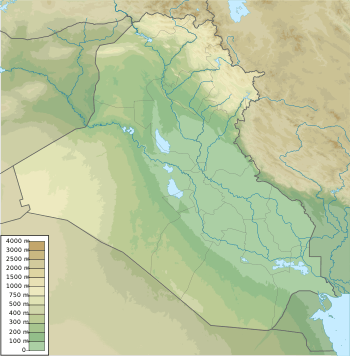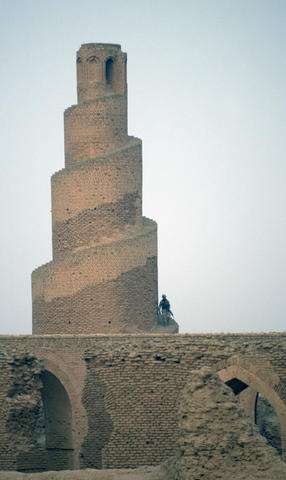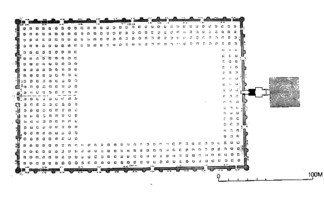Great Mosque of Samarra
The Great Mosque of Samarra (Arabic: جَامِع سَامَرَّاء ٱلْكَبِيْر, romanized: Jāmiʿ Sāmarrāʾ Al-Kabīr, Arabic: مَسْجِد سَامَرَّاء ٱلْكَبِيْر, romanized: Masjid Sāmarrāʾ Al-Kabīr, or Arabic: ٱلْمَسْجِد ٱلْجَامِع فِي سَامَرَّاء, romanized: Al-Masjid Al-Jāmiʿ fī Sāmarrāʾ, lit. 'The Great Mosque in Samarra') is a mosque from the 9th century CE located in Samarra, Iraq. The mosque was commissioned in 848 and completed in 851 by the Abbasid caliph Al-Mutawakkil who reigned (in Samarra) from 847 until 861. The mosque is located within the 15,058-hectare (37,210-acre) Samarra Archaeological City UNESCO World Heritage Site, listed in 2007.[1]
| Great Mosque of Samarra | |
|---|---|
Arabic: جَامِع سَامَرَّاء ٱلْكَبِيْر مَسْجِد سَامَرَّاء ٱلْكَبِيْر ٱلْمَسْجِد ٱلْجَامِع فِي سَامَرَّاء | |
 The spiral minaret of the mosque | |
| Religion | |
| Affiliation | Islam |
| Ecclesiastical or organisational status | Mosque and shrine |
| Status | Active |
| Location | |
| Location | Samarra, Iraq |
 Location in Iraq | |
| Geographic coordinates | 34°12′21″N 43°52′47″E |
| Architecture | |
| Type | Islamic |
| Style | Abbasid |
| Founder | Al-Mutawakkil |
| Date established | 848 CE |
| Completed | 851 CE |
| Destroyed | 1278 CE |
| Specifications | |
| Minaret(s) | 1 |
| Minaret height | 52 metres (171 ft) |
| Official name | Samarra Archaeological City |
| Criteria | Cultural: ii, iii, iv |
| Reference | 276 |
| Inscription | 2007 (31st session) |
| Endangered | 2007- |
| Area | 15,058 hectares (37,210 acres) |
| Buffer zone | 31,414 hectares (77,630 acres) |
History
The Great Mosque of Samarra was, for a time, the largest mosque in the world; its minaret, the Malwiya Tower, is a spiralling cone 52 metres (171 ft) high and 33 metres (108 ft) wide with a spiral ramp.[2] The reign of al-Mutawakkil had a great effect on the appearance of the city, for he seemed to have been a lover of architecture, and the one responsible for building the great Mosque of Samarra.[3] In a list of his building projects which appears in several different versions, the new Congregational Mosque and up to twenty palaces are mentioned, totalling between 258 and 294 million dirhams. The new Congregational Mosque, with its spiral minaret, built between 849 (235 AH) and 851 (235 AH), formed part of an extension of the city to the east, extending into the old hunting park.[4]
The mosque itself was destroyed in 1278 (656 AH) after Hulagu Khan's invasion of Iraq. Only the outer wall and its minaret remain.[5]
Former mosque
The mosque had 17 aisles, and its walls were paneled with mosaics of dark blue glass. It was part of an extension of Samarra eastwards. The art and architecture of the mosque were influential; stucco carvings within the mosque in floral and geometric designs represent early Islamic decoration. The Mosque of Ibn Tulun in Cairo, Egypt, was based on the Samarra Mosque in many regards and similarly stands in a large open space.[6]
.jpg)

Minaret
.jpg)
Al-Minārat Al-Malwiyyah (Arabic: ٱلْمِنَارَة ٱلْمَلْوِيَّة, "The Twisted Minaret" or "The Snail Shell Minaret")[7][8] was originally connected to the mosque by a bridge. The minaret or tower was constructed in 848–852 of sandstone, and is unique among other minarets because of its ascending spiral conical design. Being 52 metres (171 ft) high and 33 metres (108 ft) wide at the base, the spiral contains stairs reaching to the top.[9]
The height of the Malwiya made it practical to be used for the call to prayer. It is visible from a considerable distance in the area around Samarra and therefore may have been designed as a strong visual statement of the presence of Islam in the Tigris Valley.[9]
The minaret's unique spiral design is said by some to be derived from the architecture of the Mesopotamian ziggurats.[10] Some consider the influence of the Pillar of Gor, built in Sassanian period, more prominent.[11]
In 2005 the top of the Malwiya minaret was bombed[12]. The famous minaret was partially destroyed by insurgents. Nearly 1000 years after it had been built it finally began to crumble because of today's weapons. Many different stories and theories exist as why to the minaret was bombed. Some people state that it was to directly attack the United States forces while others say that it was to cause internal chaos within the country. Since this happened it has shortened the lifespan of the minaret.
Structures
The minaret's spiral shape inspired Pritzker Architecture Prize winner Philip Johnson's design for the 1976 Chapel of Thanksgiving at Thanks-Giving Square in Dallas, Texas, the USA.[13][14][15] The minarets of a prominent UAE mosque, that of Sheikh Khalifa in Al Ain City, have been also been inspired by this minaret.[16]
 Minaret of Abu Dulaf Mosque, also in Samarra, Iraq
Minaret of Abu Dulaf Mosque, also in Samarra, Iraq Minaret of the Mosque of Ibn Tulun
Minaret of the Mosque of Ibn Tulun Chapel of Thanksgiving at Thanks-Giving Square in Dallas, Texas, built in 1976
Chapel of Thanksgiving at Thanks-Giving Square in Dallas, Texas, built in 1976
References
- "Unesco names World Heritage sites". BBC News. 2007-06-28. Retrieved 2010-05-23.
- "Historic Mosques site". Archived from the original on 2006-07-10.
- Dennis, Sharp (1991). The Illustrated Encyclopedia of Architects and Architecture. New York: Whitney Library of Design. p. 204.
- D. Hoag., John. Islamic Architecture. Electra/Rizzoli.
- "مسجد سامرا ؛ برخوردار از مناره ای 53 متری و حلزونی شکل" (in Persian). Mehr News Agency. Retrieved 27 March 2012.
- Behrens-Abouseif, Doris (2005), Islamic architecture in Cairo: an introduction, American University in Cairo Press, pp. 51–57
- Kuban, Doğan (1974). "The Development of Early Mosque Architecture". The Mosque and Its Early Development. Leiden, Netherlands: Brill. p. 16.
- Kleiner, Fred (2011). "The Islamic World". Gardner's Art through the Ages: Backpack Edition, Book 3. Boston, the USA: CEngage Learning. p. 289.
- Kleiner, Fred S.; Christin J. Mamiya (2005). Gardner's Art Through the Ages (12th ed.). Thomson Wadsworth.
- Henri, Stierlin (1977). Comprendre l'Architecture Universelle 2. Fribourg, Switzerland: Office du Livre. p. 347.
Great mosque, Samarra, was built during the caliphate of al-Mutawakkil. It is the largest mosque in the world. Built entirely of brick within a wall flanked with towers, it has a 55 m high minaret with a spiral ramp that recalls the ziggurats of Mesopotamia
- "The city of Samarra was built during the Mu'tokul Abbasid period". Rch.ac.ir. Retrieved 10 February 2019.
- "Ancient minaret damaged in Iraq". news.bbc.co.uk. 1 April 2005.
- "Self-Guided Tour". Thanksgiving.org. Archived from the original on 2017-05-26. Retrieved 2016-11-16.
- "Travel Tips: Thanks-Giving Chapel's Islamic Design a Visual, Spiritual Gem in Downtown Dallas". WRMEA. Retrieved 10 February 2019.
- Schulze, Franz (15 June 1996). Philip Johnson: Life and Work. University of Chicago Press. ISBN 9780226740584. Retrieved 10 February 2019 – via Google Books.
- Al Nuaimi, Rashid (2019-06-28). "Iconic Al Ain mosque work in final stages". Gulf Today. Retrieved 2019-07-24.
- Necipoğlu, G., ed. (2008). Muqarnas, Volume 25 Frontiers of Islamic Art and Architecture: Essays in Celebration of Oleg Grabar's Eightieth Birthday. doi:10.1163/ej.9789004173279.i-396. ISBN 9789004173279.

- "Great Mosque of Samarra'". www.globalsecurity.org. Retrieved 2019-12-09.
- "Iraq Significant Site 060 - Samarra — Al-Mutawakkil Mosque & Minaret al-Malwiya". www.cemml.colostate.edu. Retrieved 2019-12-09.
External links
| Wikimedia Commons has media related to Great Mosque of Samarra. |
- The Great Mosque, Samarra, Iraq
- "Samarra Archaeological City". World Heritage Site. UNESCO. 2019.
- Photo of The Great Mosque
- Photo and information
- Photos, floor plans, and information
- Ernst Herzfeld Papers, Series 7: Records of Samarra Expeditions, Great Mosque of al-Mutawakkil Collections Search Center, S.I.R.I.S., Smithsonian Institution, Washington, D.C.
- Ernst Herzfeld Papers, Series 7: Records of Samarra Expeditions, 1906-1945 Smithsonian Institution, Freer Gallery of Art and Arthur M. Sackler Gallery Archives, Washington, DC

.jpg)